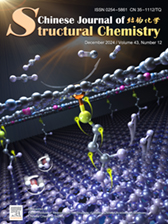
Alkyl-linked TiO2@COF heterostructure facilitating photocatalytic CO2 reduction by targeted electron transport
Jiangqi Ning, Junhan Huang, Yuhang Liu, Yanlei Chen, Qing Niu, Qingqing Lin, Yajun He, Zheyuan Liu, Yan Yu, Liuyi Li* Submit a Manuscript
Xin Wang, Changzhao Chen*, Qishen Wang, Kai Dai*
Chin. J. Struct. Chem., 2024, 43: 100473. DOI: 10.1016/j.cjsc.2024.100473
December 15, 2024
GQDs; BMO nanoflowers; Visible light photocatalysis; BPA degradation
ABSTRACT
Graphene quantum dots (GQDs) are a novel type of carbon dot material that has significant application value in the field of catalysis due to their non-toxic, stable, abundant surface functional groups, and quantum confinement effects. A unique composite photocatalyst was constructed by modifying GQDs onto Bi2MoO6 (BMO) microsphere-shaped nano petals using simple hydrothermal and sintering techniques. The structural and morphological characterization results indicate that GQDs with the size of 10 nm are well dispersed on BMO nanosheets, forming close contacts, which can greatly improve the separation efficiency of photo-generated electron-hole pairs under visible light irradiation. In the evaluation of the catalytic performance of BPA solution (20 mg/L) with a catalyst content of 20 mg under a simulated light source with a power of 300 W, the best degradation performance was achieved by a photocatalyst (G6/BMO) with the GQDs mass ratio of 6%, which degraded over 95% of BPA under visible light within 120 min, while pure BMO only degraded about 45% of BPA during the same time period. Even if the 400 nm filter is removed and directly exposed to Xe lamp radiation, the degradation performance of the optimal composite catalyst is only slightly improved, indicating that the current GQDs/BMO composite catalyst has extremely strong visible light catalytic activity. The improvement of catalytic performance comes from the effective separation of electron-hole pairs caused by the absorption of electrons by GQDs, and the introduction of GQDs to reduce the band gap and enhance visible light absorption, both of which are beneficial for catalytic reactions. Free radical capture and electron spin resonance (ESR) tests indicate that ·OH and ·O2− are the main active species for BPA degradation. Although the current GQDs/BMO catalysts have a simple structure, their catalytic performance has significantly improved, which will guide the design of other semiconductor based photocatalysts.






